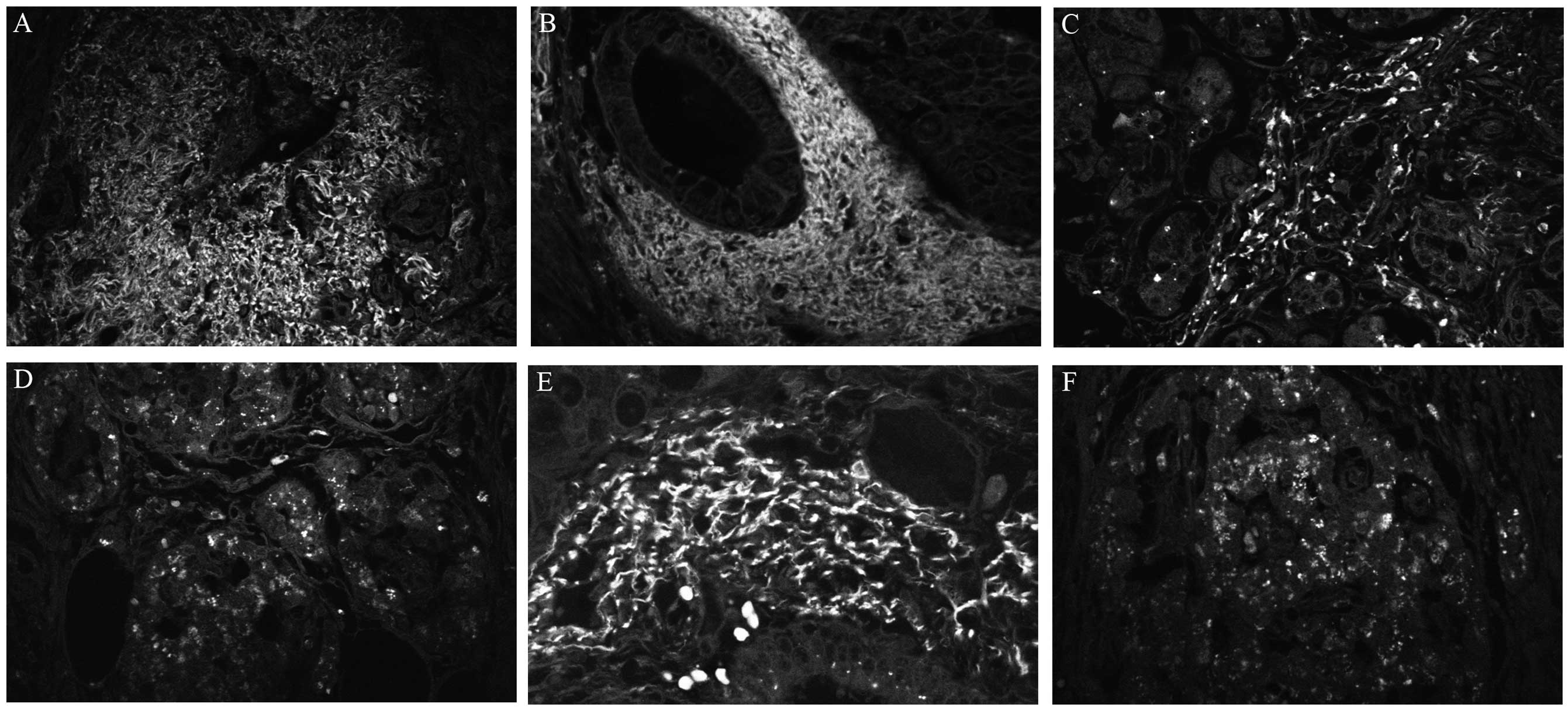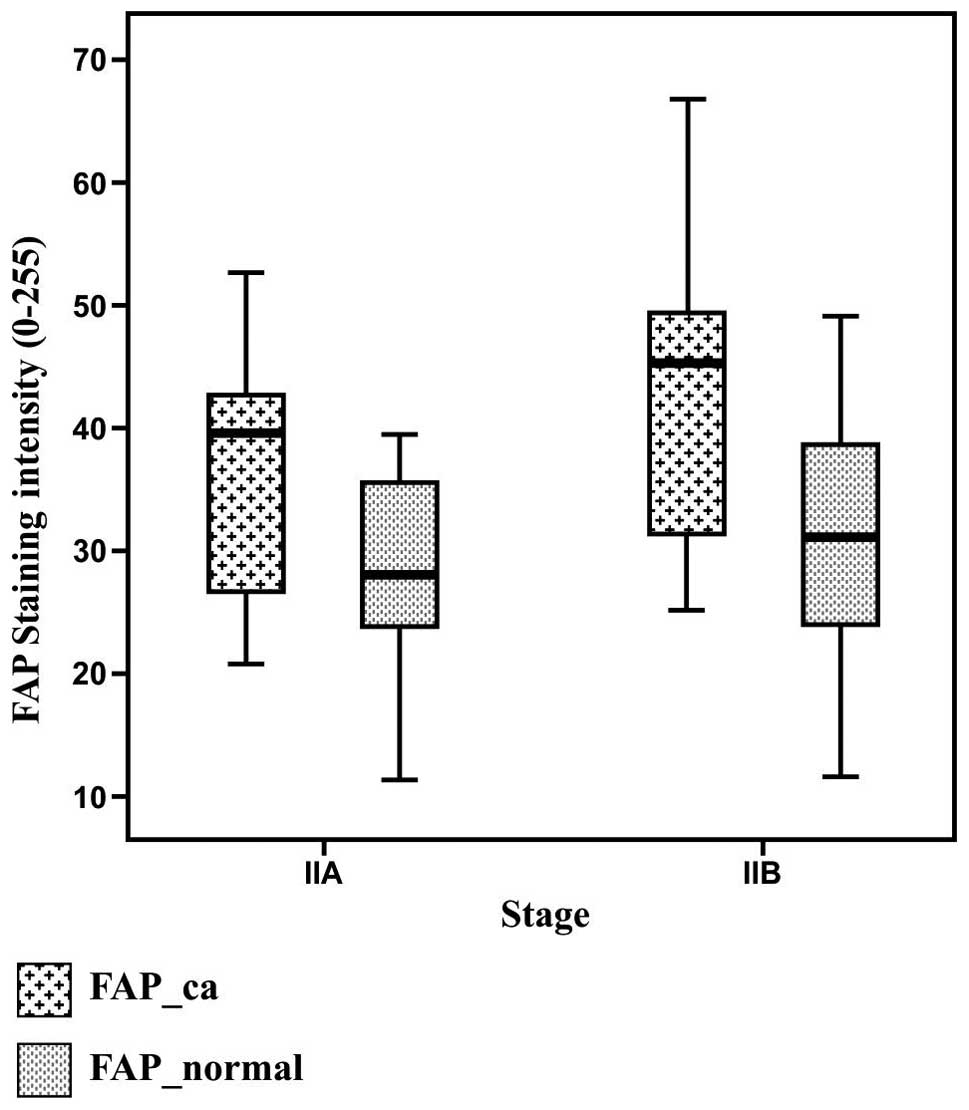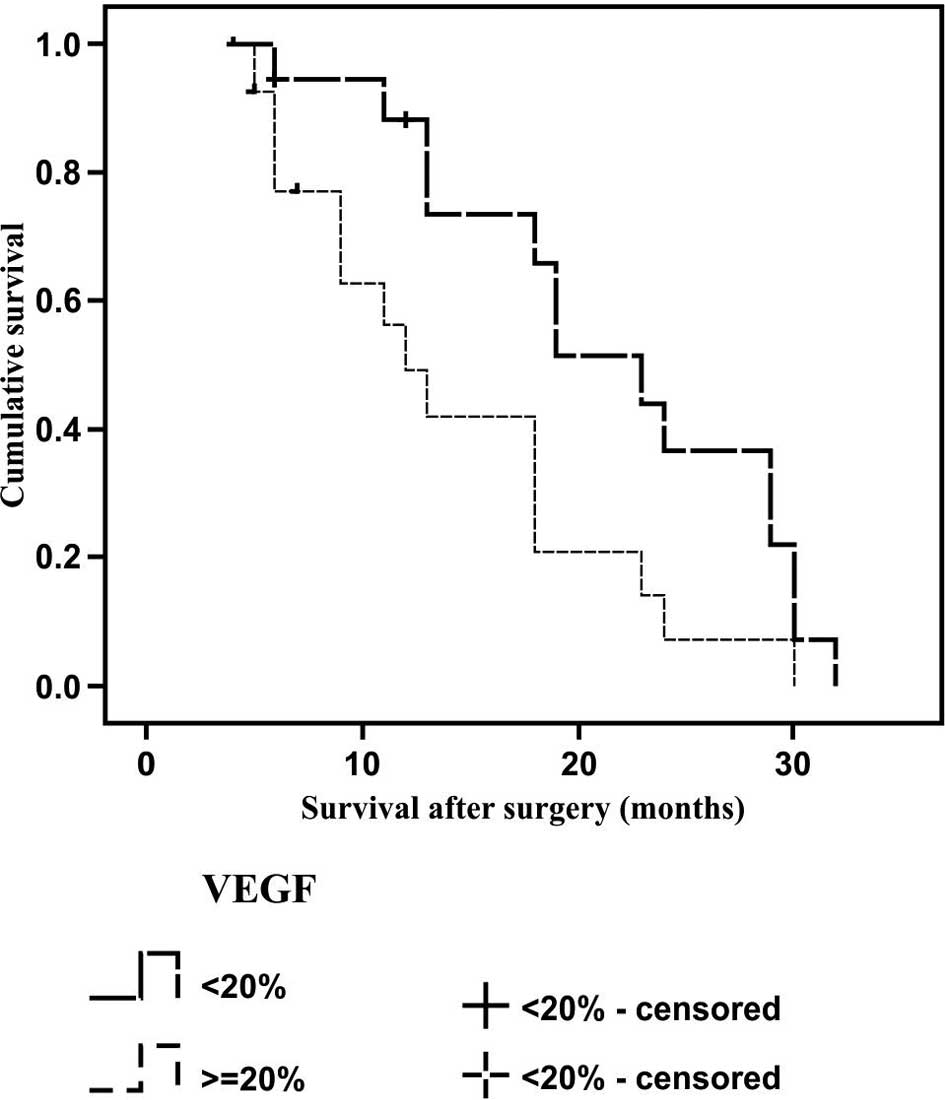|
1
|
Siegel R, Naishadham D and Jemal A: Cancer
statistics, 2013. CA Cancer J Clinic. 63:11–30. 2013. View Article : Google Scholar
|
|
2
|
Crist DW and Cameron JL: The current
status of the Whipple operation for periampullary carcinoma. Adv
Surg. 25:21–49. 1992.PubMed/NCBI
|
|
3
|
Sohn TA, Yeo CJ, Cameron JL, et al:
Resected adenocarcinoma of the pancreas-616 patients: results,
outcomes and prognostic indicators. J Gastrointest Surg. 4:567–579.
2000. View Article : Google Scholar
|
|
4
|
Cleary SP, Gryfe R, Guindi M, et al:
Prognostic factors in resected pancreatic adenocarcinoma: analysis
of actual 5-year survivors. J Am Coll Surg. 198:722–731. 2004.
View Article : Google Scholar : PubMed/NCBI
|
|
5
|
Han SS, Jang JY, Kim SW, Kim WH, Lee KU
and Park YH: Analysis of long-term survivors after surgical
resection for pancreatic cancer. Pancreas. 32:271–275. 2006.
View Article : Google Scholar : PubMed/NCBI
|
|
6
|
Moon HJ, An JY, Heo JS, Choi SH, Joh JW
and Kim YI: Predicting survival after surgical resection for
pancreatic ductal adenocarcinoma. Pancreas. 32:37–43. 2006.
View Article : Google Scholar
|
|
7
|
Matsuno S, Egawa S, Fukuyama S, et al:
Pancreatic cancer registry in Japan: 20 years of experience.
Pancreas. 28:219–230. 2004. View Article : Google Scholar : PubMed/NCBI
|
|
8
|
Whitehurst B, Flister MJ, Bagaitkar J, et
al: Anti-VEGF-A therapy reduces lymphatic vessel density and
expression of VEGFR-3 in an orthotopic breast tumor model. Int J
Cancer. 121:2181–2191. 2007. View Article : Google Scholar : PubMed/NCBI
|
|
9
|
Christiansen A and Detmar M:
Lymphangiogenesis and cancer. Genes Cancer. 2:1146–1158. 2011.
View Article : Google Scholar
|
|
10
|
Shinkaruk S, Bayle M, Laïn G and Déléris
G: Vascular endo-thelial cell growth factor (VEGF), an emerging
target for cancer chemotherapy. Curr Med Chem Anticancer Agents.
3:95–117. 2003. View Article : Google Scholar : PubMed/NCBI
|
|
11
|
Brown LF, Guidi AJ, Schnitt SJ, et al:
Vascular stroma formation in carcinoma in situ, invasive carcinoma
and metastatic carcinoma of the breast. Clin Cancer Res.
5:1041–1056. 1999.PubMed/NCBI
|
|
12
|
Fukumura D, Xavier R, Sugiura T, et al:
Tumor induction of VEGF promoter activity in stromal cells. Cell.
94:715–725. 1998. View Article : Google Scholar : PubMed/NCBI
|
|
13
|
Senger DR, Galli SJ, Dvorak AM, Perruzzi
CA, Harvey VS and Dvorak HF: Tumor cells secrete a vascular
permeability factor that promotes accumulation of ascites fluid.
Science. 219:983–985. 1983. View Article : Google Scholar : PubMed/NCBI
|
|
14
|
Dvorak HF, Sioussat TM, Brown LF, et al:
Distribution of vascular permeability factor (vascular endothelial
growth factor) in tumors: concentration in tumor blood vessels. J
Exp Med. 174:1275–1278. 1991. View Article : Google Scholar : PubMed/NCBI
|
|
15
|
Feng D, Nagy JA, Brekken RA, et al:
Ultrastructural localization of the vascular permeability
factor/vascular endothelial growth factor (VPF/VEGF) receptor-2
(FLK-1, KDR) in normal mouse kidney and in the hyperpermeable
vessels induced by VPF/VEGF-expressing tumors and adenoviral
vectors. J Histochem Cytochem. 48:545–556. 2000. View Article : Google Scholar : PubMed/NCBI
|
|
16
|
Leung DW, Cachianes G, Kuang WJ, Goeddel
DV and Ferrara N: Vascular endothelial growth factor is a secreted
angiogenic mitogen. Science. 246:1306–1309. 1989. View Article : Google Scholar : PubMed/NCBI
|
|
17
|
Mahadevan D and Von Hoff DD: Tumor-stroma
interactions in pancreatic ductal adenocarcinoma. Mol Cancer Ther.
6:1186–1197. 2007. View Article : Google Scholar : PubMed/NCBI
|
|
18
|
Ikeda N, Adachi M, Taki T, et al:
Prognostic significance of angiogenesis in human pancreatic cancer.
Br J Cancer. 79:1553–1563. 1999. View Article : Google Scholar : PubMed/NCBI
|
|
19
|
Itakura J, Ishiwata T, Shen B, Kornmann M
and Korc M: Concomitant over-expression of vascular endothelial
growth factor and its receptors in pancreatic cancer. Int J Cancer.
85:27–34. 2000. View Article : Google Scholar
|
|
20
|
Fujimoto K, Hosotani R, Wada M, et al:
Expression of two angiogenic factors, vascular endothelial growth
factor and platelet-derived endothelial cell growth factor in human
pancreatic cancer and its relationship to angiogenesis. Eur J
Cancer. 34:1439–1447. 1998. View Article : Google Scholar : PubMed/NCBI
|
|
21
|
Park JE, Lenter MC, Zimmermann RN,
Garin-Chesa P, Old LJ and Rettig WJ: Fibroblast activation protein,
a dual specificity serine protease expressed in reactive human
tumor stromal fibroblasts. J Biol Chem. 274:36505–36512. 1999.
View Article : Google Scholar : PubMed/NCBI
|
|
22
|
Garin-Chesa P, Old LJ and Rettig WJ: Cell
surface glycoprotein of reactive stromal fibroblasts as a potential
antibody target in human epithelial cancers. Proc Nat Acad Sci USA.
87:7235–7239. 1990. View Article : Google Scholar : PubMed/NCBI
|
|
23
|
Scanlan MJ, Raj BK, Calvo B, et al:
Molecular cloning of fibroblast activation protein alpha, a member
of the serine protease family selectively expressed in stromal
fibroblasts of epithelial cancers. Proc Nat Acad Sci USA.
91:5657–5661. 1994. View Article : Google Scholar : PubMed/NCBI
|
|
24
|
Mueller MM and Fusenig NE: Tumor-stroma
interactions directing phenotype and progression of epithelial skin
tumor cells. Differentiation. 70:486–497. 2002. View Article : Google Scholar : PubMed/NCBI
|
|
25
|
Liotta LA, Steeg PS and Stetler-Stevenson
WG: Cancer metastasis and angiogenesis: an imbalance of positive
and negative regulation. Cell. 64:327–336. 1991. View Article : Google Scholar : PubMed/NCBI
|
|
26
|
Cohen SJ, Alpaugh RK, Palazzo I, et al:
Fibroblast activation protein and its relationship to clinical
outcome in pancreatic adenocarcinoma. Pancreas. 37:154–158. 2008.
View Article : Google Scholar : PubMed/NCBI
|
|
27
|
Goscinski MA, Suo Z, Florenes VA,
Vlatkovic L, Nesland JM and Giercksky KE: FAP-alpha and uPA show
different expression patterns in premalignant and malignant
esophageal lesions. Ultrastruct Pathol. 32:89–96. 2008. View Article : Google Scholar : PubMed/NCBI
|
|
28
|
Henry LR, Lee HO, Lee JS, et al: Clinical
implications of fibroblast activation protein in patients with
colon cancer. Clin Cancer Res. 13:1736–1741. 2007. View Article : Google Scholar : PubMed/NCBI
|
|
29
|
Földes-Papp Z, Demel U and Tilz GP: Laser
scanning confocal fluorescence microscopy: an overview. Int
Immunopharmacol. 3:1715–1729. 2003. View Article : Google Scholar : PubMed/NCBI
|
|
30
|
Amos WB and White JG: How the confocal
laser scanning microscope entered biological research. Biol Cell.
95:335–342. 2003. View Article : Google Scholar : PubMed/NCBI
|
|
31
|
Papaxoinis K, Patsouris E, Kittas C and
Nicolopoulou-Stamati P: Insulinlike growth factor I receptor and
estrogen receptor beta expressions are inversely correlated in
colorectal neoplasms and affected by the insulin resistance
syndrome. Hum Pathol. 38:1037–1046. 2007. View Article : Google Scholar : PubMed/NCBI
|
|
32
|
Mason DY, Micklem K and Jones M: Double
immunofluorescence labelling of routinely processed paraffin
sections. J Pathol. 191:452–461. 2000. View Article : Google Scholar : PubMed/NCBI
|
|
33
|
Hamilton SR and Aaltonen LA: Pathology and
Genetics of Tumours of the Digestive System. World Health
Organization Classification of Tumours. Kleihues P and Sobin LH:
IARC Press; Lyon: pp. 1–250. 2000
|
|
34
|
Giulianotti PC, Boggi U, Fornaciari G, et
al: Prognostic value of histological grading in ductal
adenocarcinoma of the pancreas. Klöppel vs TNM grading. Int J
Pancreatol. 17:279–289. 1995. View Article : Google Scholar : PubMed/NCBI
|
|
35
|
Edge SB, Byrd DR, Compton CC, et al: AJCC
Cancer Staging Manual. 7th. Springer; New York, NY: pp. 241–249.
2010
|
|
36
|
Kraman M, Bambrough PJ, Arnold JN, et al:
Suppression of antitumor immunity by stromal cells expressing
fibroblast activation protein-alpha. Science. 330:827–830. 2010.
View Article : Google Scholar : PubMed/NCBI
|
|
37
|
Shi M, Yu DH, Chen Y, et al: Expression of
fibroblast activation protein in human pancreatic adenocarcinoma
and its clinicopathological significance. World J Gastroenterol.
18:840–846. 2012. View Article : Google Scholar : PubMed/NCBI
|
|
38
|
Smith RA, Tang J, Tudur-Smith C,
Neoptolemos JP and Ghaneh P: Meta-analysis of immunohistochemical
prognostic markers in resected pancreatic cancer. Br J Cancer.
104:1440–1451. 2011. View Article : Google Scholar : PubMed/NCBI
|
|
39
|
Kindler HL, Ioka T, Richel DJ, et al:
Axitinib plus gemcitabine versus placebo plus gemcitabine in
patients with advanced pancreatic adenocarcinoma: a double-blind
randomised phase 3 study. Lancet Oncol. 12:256–262. 2011.
View Article : Google Scholar : PubMed/NCBI
|
|
40
|
Spano JP, Chodkiewicz C, Maurel J, et al:
Efficacy of gemcitabine plus axitinib compared with gemcitabine
alone in patients with advanced pancreatic cancer: an open-label
randomised phase II study. Lancet. 371:2101–2108. 2008. View Article : Google Scholar : PubMed/NCBI
|
|
41
|
Cirri P and Chiarugi P: Cancer associated
fibroblasts: the dark side of the coin. Am J Cancer Res. 1:482–497.
2011.PubMed/NCBI
|
|
42
|
Rettig WJ, Garin-Chesa P, Healey JH, et
al: Regulation and heteromeric structure of the fibroblast
activation protein in normal and transformed cells of mesenchymal
and neuroectodermal origin. Cancer Res. 53:3327–3335.
1993.PubMed/NCBI
|
|
43
|
Crawford Y, Kasman I, Yu L, et al: PDGF-C
mediates the angiogenic and tumorigenic properties of fibroblasts
associated with tumors refractory to anti-VEGF treatment. Cancer
Cell. 15:21–34. 2009. View Article : Google Scholar
|












